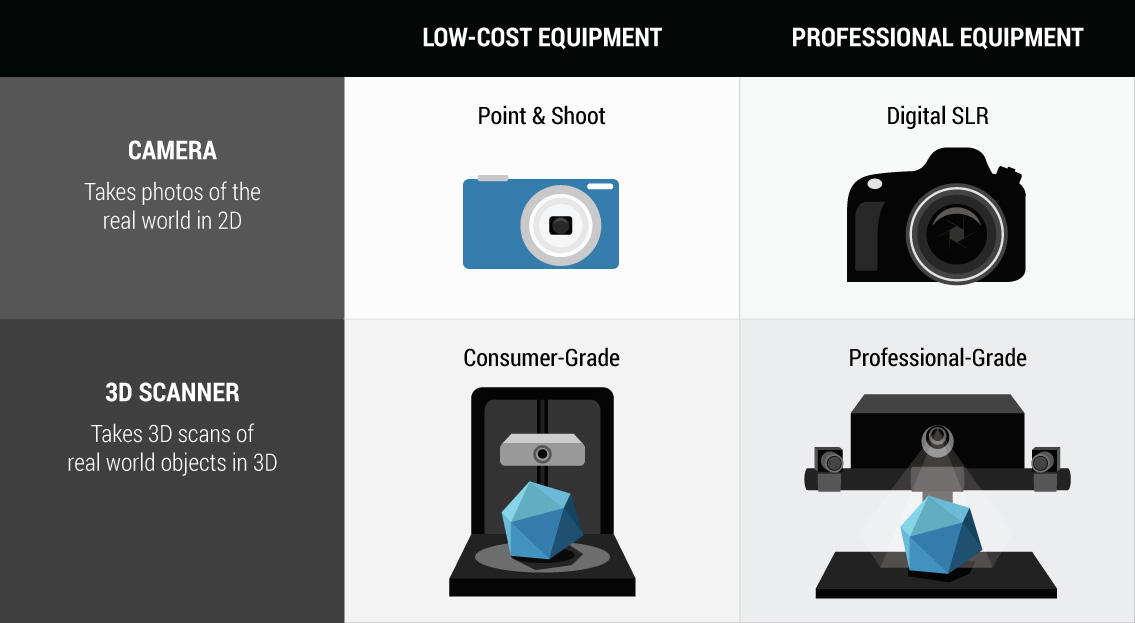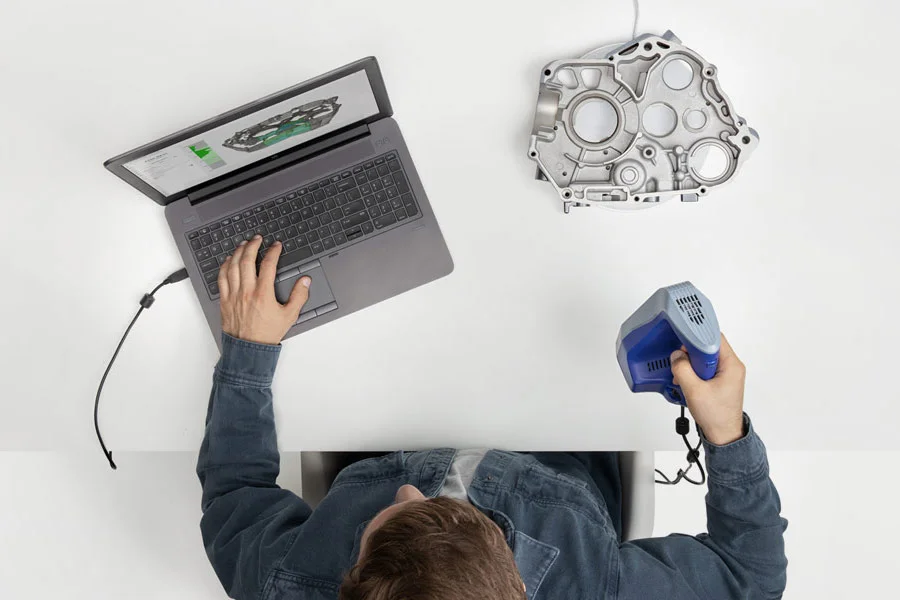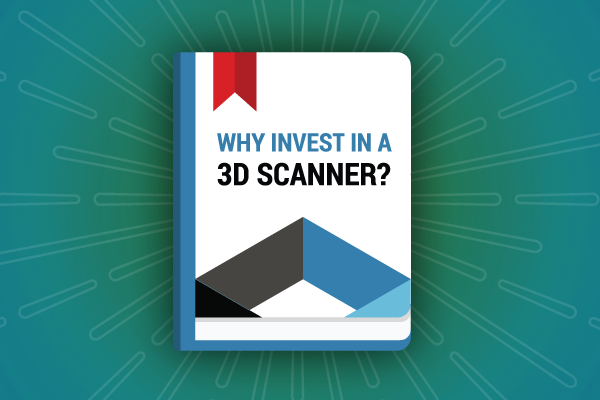
Budget is a key factor that contributes to the buying decision. It is a sensitive topic but it needs to be addressed in order to set realistic expectations. When researching on which 3D scanner to buy, one of the things you’ll notice is prices range from less than $1,000 for consumer-grade 3D scanners all the way to upward of $10000+ for professional-grade systems.
We are more likely to be exposed to the low prices associated with consumer-grade scanners. When shopping for a professional-grade scanner to use in industry applications—whether it’s for reverse engineering, quality inspection, or scientific measurement—people are often surprised to find out these systems are substantially more expensive. Why is there such a discrepancy in prices?
Same Functionality, Difference in Quality
We can explain the fundamental difference between consumer-grade versus professional-grade 3D scanners using cameras as an example as the technology is similar to 3D scanners. In terms of functionality, cameras translate the real world in the form of 2D images while 3D scanners take 3D images.

All cameras have the ability to take photos but when you compare a point and shoot camera with a digital SLR, the latter will produce better image quality (i.e. sharper images, better sensitivity to light, less noise/distortion in photos). More expensive cameras like the digital SLRs use high end components (i.e. better sensors and lenses) and therefore produce higher quality results compared to point and shoot cameras. Because digital SLRs use higher quality components that are more expensive, this is reflected in the price.
The same can be said for 3D scanners when comparing consumer versus professional-grade systems. Professional 3D scanners used for industry applications deliver significantly better raw scan data quality, when compared to its consumer counterpart.
| Consumer-Grade 3D Scanners | Professional-Grade 3D Scanners | |
|---|---|---|
| Price | Low-cost (under $1,000) | More expensive than consumer-grade 3D scanners (typically around $10,000-$20,000 or higher) |
| User | Consumers, hobbyists, and start-ups mainly use it for 3D visualization or 3D printing. | Companies, organizations, and academic institutions use them to collect 3D measurements that can be used for various applications. |
| Applications | Home use or limited applications where quality of 3D scans (accuracy, resolution, and repeatability) is not important. Consumer-grade scanners are not intended for industry applications unless otherwise stated. It’s similar to using a bathroom scale for commercial purposes. | Applications where accuracy, repeatability and resolution are important. Scan data quality is much cleaner and less noisy. |
| Scan Quality | Low quality. Small scanning window (usually desktop size) or capture large scanning window (scanning an entire room). | Get high quality scan data due to better electronics and parts (industrial grade cameras, lenses, sensors). |
| Important Factor | Cost over quality | Reliability and scan quality |
How is Scan Quality Defined?

Consumer 3D Scanners
Low Scan Quality

Professional 3D Scanners
High Scan Quality
Scan quality is defined as how good the scanner is at capturing raw output (digital 3D measurement coordinates known as point cloud) from the physical environment. The data has not been subjected to post-processing or any other modifications. Scan data quality can be defined by several factors. There is a direct relationship between these factors and price–you will have to pay more for better results.
Accuracy
How true a measurement is to the real value of the object.
For 3D scanners, accuracy is usually defined by depth or dimensional accuracy and it’s the most important aspect for 3D measurement equipment. All measurement devices, including 3D scanners, are not perfect and can never achieve the true measurement value of the object.
Resolution
How many 3D measurement points a scanner collects from the surface of real world objects. Similar to accuracy, you should get the resolution you are comfortable with for your application.
Cleanliness (versus noisy scan data)
Scan data can be noisy if the scanner doesn’t use industrial-grade components (cameras, camera sensors, lenses) to produce high quality results, which you normally don’t see in consumer-grade scanners.
Scan speed also affects the cleanliness of the scan data. If the scanner is scanning slowly and the scan target (i.e. person) moves during the scanning process, it can cause noisy data. If the scanner is fast at taking scans (< 1 second), the effect of slight movement is minimized.
Repeatability
Variations in the measurements taken from the same equipment on the same scan target.
Professional-grade scanners go through rigorous testing to ensure you get the same results every time. When you depend on 3D scan data for decision-making where your company’s reputation is on the line, it’s important to know that the data you are using can be trusted.
What other factors affect 3D scanner price?
Besides scan data quality, other factors affect the price of a 3D scanner.
3D Scanning Software
The 3D scanning software that comes with a professional-grade 3D scanner is more sophisticated, in terms of data acquisition and processing capabilities, when compared with the software found in a consumer-grade scanner. The software gives you more control over the scan data by having more features for data acquisition, cleanup, merging, and aligning 3D scans into a digital 3D model for downstream applications.
Stability to Variations in Environmental Conditions
Professional 3D scanners, typically higher end professional-grade systems, are ruggedly built for tough conditions to withstand temperature fluctuation in the working environment. This is especially important for quality inspection applications where the 3D scanner must be trusted to generate repeatable scanning results every time.
The Best Option Isn’t Necessarily the Most Expensive
There is a quality difference when you look at consumer-grade scanners compared to professional-grade scanners and this is reflected in the price. However, the best 3D scanners out there aren’t necessarily the most expensive. Get what you need for scan quality and don’t overpay for what you don’t need.
Define the factors most important to you by examining what application you will use the scanner for and get the system that best fits your needs. It’s important to get the right tool for the job.




I thought this article was actually going somewhere and there was a scanner out there that was professional quality at a consumer price….
Dear Steve,
Your comment highlights an important point of the article. There are tradeoffs when it comes to buying any equipment, including 3D scanners. You can get an inexpensive scanner but the tradeoff is you will have lower quality scan data. If you want to have high quality scan data, it will cost more. The purpose of the article is to explain what factors contribute to the price difference between a consumer-grade 3D scanner compared to a professional-grade 3D scanner.
Very questionable ranking. There are some systems under $10k that can give professional results (good accuracy and resolution). For sure there will some tradeoffs, like lack of blue-light technology or something loved by pros, but they can compete with system priced $10-20k.
Thanks for your feedback Andrey. We appreciate the diversity of opinions in our comments section. Our goal for this article is not to provide a ranking of 3D scanners. But we wanted to answer the general question of why there are price discrepancies between a consumer-grade 3D scanner (under $1,000 as we explicitly stated in our article) to professional ones. We agree that there are trade-offs when purchasing more expensive 3D scanners compared to more affordable ones. As we mention in our article, we acknowledge that the best 3D scanners out there aren’t necessarily the most expensive. You should get a 3D scanner that meets your needs in terms of scan quality and other criteria important in your consideration (whether it’s $1,000, $5,000, or $10,000 ). Don’t overpay for what you don’t need. We recommend people looking to purchase a scanner to research as much as they need before purchasing. Don’t be afraid to ask questions to 3D scanner suppliers and see if they are helpful in your purchasing decision.
you can built a pro level scanner, applying the same workflow (structured light using projectors/cameras) for a fraction of the cost. but you will need to invest time, fight with bugs, alignments, software (dark paths), bulkiness/portability/durability etc. there are some tutorials out there for all this.
depending on the objects/use and your processing power/time available, you can also produce highly detailed 3D scans with photogrammetry, with no need of special tools and rigs.
professionals who make money and resell the services can afford the price and want to skip all the hassle. that is why companies can earn a load of money by selling inferior hardware but plug and play software/hardware solutions.
pros of the diy way is of course knowledge (that can make money by itself) and that usually the projectors/cameras that you use are non proprietary and with a correct setup they can have other usages, as well.
I agree that it all depends on your needs, your technical skill level, and your willingness to spend time tinkering to build your own 3D scanner. If you want to spend the time and do research on putting together a DIY system, that works great for people who are highly technical and know what they are doing. For people who don’t have the time to spend on doing this, purchasing a turkey system might be better suited for them.